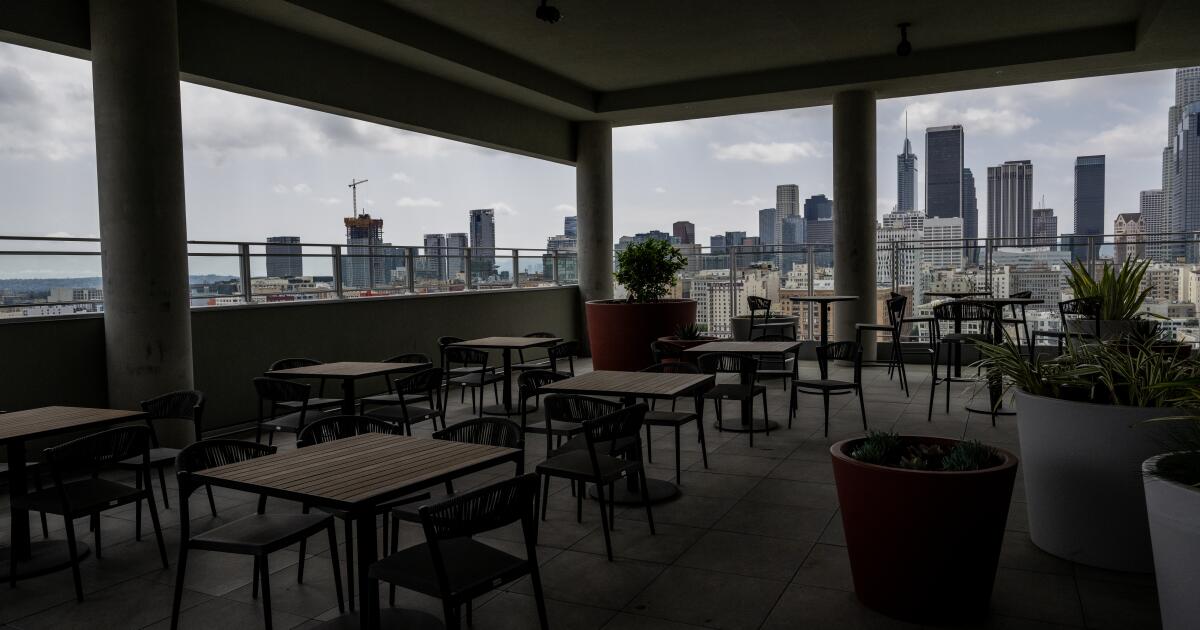
In the 1980s and ‘90s, California was in the thrall of the “slow growth” movement. Goaded particularly by increasing traffic, communities fought hard against the construction of office buildings, shopping centers and big apartment complexes.
Homeowners hurled “high-rise” like a curse. Ballot measures stifled construction in many cities. In 1986, voters in Los Angeles voted 2 to 1 to approve the landmark Proposition U, which cut in half the size of new buildings proposed for most of the city’s commercial and industrial zones.
The slow-growth trend began to ebb not long into the new millennium. It finally flipped dramatically last week, when the state Legislature approved a bill that would clear a path for high-rise residential buildings near many bus and rail stops.
SB 79 will be sent in October to Gov. Gavin Newsom, who is expected to sign the measure, which will override local zoning — permitting construction of up to nine stories, in some cases — for builders who propose housing projects within half a mile of transit stations.
The bill by Sen. Scott Wiener (D-San Francisco) verges on extraordinary, not only because of the size of the buildings it would allow but because it takes county and city elected officials mostly out of the equation on many construction projects.
Wiener contends that local officials have not done enough to address the state’s monumental housing shortage and, at the extreme, are forcing the poorest Californians into homelessness.
The San Francisco liberal tried but failed to win approval for a version of the law in three prior years. Wiener promised that the latest iteration will put more people in apartments near bus and rail lines, keeping them off jammed freeways.
“Today’s vote is a dramatic step forward to undo these decades of harm, reduce our most severe costs, and slash traffic congestion and air pollution in our state,” the lawmaker said in a statement.
Wiener’s bill won final approval from the Legislature on Friday after a string of amendments were added that presumably made it more palatable to rural and suburban lawmakers. One change means that the upzoning near transit hubs will apply in only eight of the state’s 58 counties — Los Angeles, Orange, San Diego, Santa Clara, Alameda, San Francisco, San Mateo and Sacramento.
Still, a coalition of community and homeowner groups in those counties, United Neighbors, said the law will force apartments into neighborhoods of single-family homes and makes no provision for parks and other amenities that help communities thrive.
The Los Angeles City Council narrowly moved to oppose the bill and Mayor Karen Bass agreed, saying cities like L.A., with state-approved plans called “housing elements,” should be exempt from the law.
For homeowner groups, once an unassailable power in California politics, the advance of SB 79 has been a rude awakening. They depict the law as a blunt instrument that fails to acknowledge the work many communities already have done to draw up housing plans.
Jeff Kalban, an architect and Sherman Oaks Homeowners Assn. activist, predicted that large swaths of Sherman Oaks, Van Nuys, Valley Village and other communities will shift from single-family homes to large apartment complexes. An L.A. city housing plan that took years to win approval early this year, envisioning “a more beautiful and vibrant community, is gone, all gone,” said Kalban, designer of multiple schools and other well-known spaces.
Looking out from his fourth-floor office in Sherman Oaks, Kalban said he could see “the California dream, the American dream,” adding: “And it’s all being obliterated because Scott Wiener does not like single-family neighborhoods.”
The “not in my back yard” (NIMBY) forces of 30 and 40 years ago have been joined in the debate over the state’s future by California YIMBY, a group that says “yes” to housing development. The group predicted that Californians skeptical of the new law will get on board, once they see the results, with most new buildings well under the new nine-story limit.
“We’re just as likely to see what’s called ‘moderate density’ housing — fourplexes, six-plexes, four-floor walk-up flats — that were legal in most of California until the 1980s or so, when cities banned them,” California YIMBY spokesperson Matthew Lewis said. “Many Californians already have those buildings in our neighborhoods from the 1960s and ‘70s. SB 79 means we’ll see a few more.”
The week’s biggest stories
Trump vs. the University of California
Most Jewish Americans oppose Trump’s university funding cuts over antisemitism, a poll shows.
UC employees, not waiting on their leaders, sued Trump for ‘financial coercion’ over UCLA cuts.
Hollywood business shakeups
Here’s what it means for Hollywood if Paramount and Warner Bros. merge.
Disney, Universal and Warner Bros. Discovery sue Chinese AI firm as Hollywood’s copyright battles spread.
Robert Redford remembered
The film giant and Sundance founder was an “artistic gamechanger.”
Never just the Sundance kid, Robert Redford chased complexity at every turn, film critic Amy Nicholson writes.
Here are 10 essential Robert Redford films that remain ingrained in our collective memory.
Harassment and retaliation allegations at the Orange County district attorney’s office
A lawsuit by a former prosecutor alleges she was sexually harassed and retaliated against while working for the Orange County district attorney’s office.
The Orange County district attorney’s office said it launched an investigation into the allegations of sexual harassment with an outside agency.
Charlie Kirk killing
Prosecutors will seek the death penalty for the suspect.
White supremacists disrupted vigils for the slain conservative activist in Huntington Beach, marching and chanting, “White men fight back.”
Trump’s order to lower flags for Kirk has sparked fierce battles at the local level, in Southern California and beyond.
What else is going on
As the Prop. 50 fight intensifies, Newsom and partisan influencers rally their bases.
Starbucks becomes a founding-level partner for the 2028 L.A. Olympic Games.
California issues an advisory on a parasitic fly whose maggots can infest living humans.
A judge rejected petitions by Erik and Lyle Menendez to overturn their convictions.
Proposition 50 would gerrymander the state and decimate Republican representation in Congress. Columnist Mark Z. Barabak asks: What do Democrats running for governor say to California’s millions of GOP voters?
Charlie Kirk gave young men something to believe in. Newsom wants to do the same, argues columnist Anita Chabria.
This morning’s must reads
Other must reads
When the evidence hissed: The snake-killer trial that led to California’s last hanging.
An Angeleno dines in Mexican Chicago. They’re just like us.
This Armenian meat market’s viral social media strategy? Sexy steaks.
For your downtime
Going out
Concerts: More than four decades after their “farewell” tour, the Who returns one (last?) time to the Hollywood Bowl on Wednesday and Friday.
Movies: Are the “Downton Abbey” and “Conjuring” finales essentially the same movie?
Coachella: The Coachella 2026 lineup dropped. Sabrina Carpenter, Justin Bieber and Karol G will headline the festival.
Staying in
Television: Where did we come from? The BBC docuseries “Human” is an exhilarating origin story, says reviewer Robert Lloyd.
Music: Saint Etienne goes out with a bang (and a big party) on its final album “International.”
Books: Karen Palmer’s memoir details abuse, forgery, kidnapping and breakdown.
Recipes: Here’s a recipe for polenta hash.
✏️ Get our free daily crossword puzzle, sudoku, word search and jigsaw games.
And finally … your photo of the day
Today’s great photo is from contributing photographer Michael Owen Baker of Neil Young and the Chrome Hearts performing at the Hollywood Bowl.
Have a great day, from the Essential California team
Jim Rainey, staff reporter
Hugo Martín, assistant editor, fast break desk
Kevinisha Walker, multiplatform editor
Andrew Campa, Sunday writer
Karim Doumar, head of newsletters



